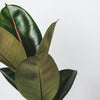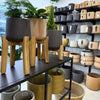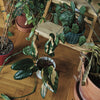Climbing plants epipremnum and scindapsus

Creeper, creeper, fool, pothos/potos, devil's ivy, epipremnum, scindapsus - have you ever heard these names? We bet you do! All of them refer to very popular, unpretentious and fast-growing houseplants, which were already grown by our grandmothers' grandmothers and are still in the limelight today, not only thanks to the new beautifully colored varieties.
Most members of the Epipremnum genus are characterized by cordate glossy to leathery leaves, often variegated in color, that grow from long, sturdy stems with aerial roots. They grow well through a soft support in the form of a moss or peat stick . We can also grow them in a hanging flower pot , in a macrame flower pot or just let their stems hang. These plants can also be grown very well in hydroponics, for example in expanded clay . On the other hand, species of the genus Scindapsus have somewhat firmer leaves with a hint of silver, which literally sparkle in the sun. In addition, plants from these genera have very similar requirements for cultivation and care, which is why we dedicate a joint article to them here.
Epipremnum
This genus belongs to the Aronaceae family , together with the popular philodendrons, monsters and dieffenbachias, and we can find here more than 20 species of large, powerful vines that were discovered and described by the botanist Heinrich Wilhelm Schott in tropical Indonesia and Australia in the second half of the 19th century. The determination of botanical classification has a long history. Perhaps no other species of houseplants are so often misclassified and misnamed as the best-known species Epipremnum aureum . Now the only correct name is really this. Previously, the mentioned species was described as Pothos aureus , later it was even transferred to the genus Scindapsus , but it was not until almost 100 years later that the adult flowering forms of this species were discovered and, based on their morphology, the final inclusion in the genus Epipremnum took place . Thanks to these historical inconsistencies , a misnomer like 'pothos' has become so ingrained that people still use it often today, perhaps for easier pronunciation. But you will always know how it is right, right?

Photo: Epipremnum Golden, Epipremnum Neon, Epipremnum Marble Queen
Which epipremnum to choose?
There are many species of the genus Epipremnum , and they all have beautifully colored distinctive glossy leaves in common. The most well-known representative from this category is certainly Epipremnum aureum , which has yellow to golden (which is why it is sometimes referred to as the golden variant) variegated leaves in the shape of an elongated heart. A similar, but to the observant eye still different variant is Epipremnum Marble Queen . The leaves are variegated rather white or light green and their pattern resembles marble. Epipremnum Happy leaf has leaves slightly similar to the previous species, but they are as if wavy and white or light spots on the leaves take up more space. Another beautiful and cheerful variant is called Epipremnum Global Green , its leaves are also slightly wrinkled, but compared to Happy leaf , it is more green. However, it is important to emphasize that all color and degree of annealing depends on the amount of light that the plant receives.
Another popular bright to neon green variant is Epiprepremum Neon and a white-green variant with smaller leaves called Epipremnum N'joy .
In our e-shop, less well-known rarer pieces are also available, such as Epipremnum Silver Streak , which is proud of its elongated silvery green leaves, or a variant with slightly cut and white variegated leaves of Epipremnum pinnatum variegata . Arrow-shaped leaves with a touch of silver color can also be found on Epipremnum Cebu Blue , and a beautiful variant with arrow-shaped leaves that also form perforations when mature (similar to Monstera) is worth mentioning, namely Epipremnum Blue Form .

Photo: Scindapsus pictus Argyraeus
Scindapsus
The genus Scindapsus is also part of the aron family (aroids) and it is true that it is often confused with the aforementioned genera. However, the plants with this name are characterized by their slightly firmer leaves, in the color palette of light green, dark green and silver. The surface of the leaf is almost velvety and slightly shiny. The drawing of the leaves is very similar in the individual species, but after a more thorough examination, the differences can be reliably determined.
And which scindapsus is the best?
Scindapsus pictus Trebi , also called Sp Exotica, has probably the largest leaves , which you can also recognize by the pale silvery fields with a green central line. Scindapsus pictus Argyraeus has slightly smaller but cute heart-shaped dark green leaves that are speckled with silver. This species is very similar to the species Scindapsus pictus Silvery Anne , but the silver fields are not as evenly spaced and often have a larger number. An unmistakable variant is the beautiful rarer Scindapsus treubii Moonlight , which boasts large silver leaves with a slightly greenish edge and central leaf line. The species that quite stands out in this genus is the rare Scindapsus treubii Dark , which has elongated and distinctly dark green to black leaves.
How to take care of them?
Climbing plants are really undemanding plants that will thrive in a light or dark place. Most likely, any beginner can keep them alive. And not only that! With a little effort and the occasional dew , they will literally grow before your eyes. If you are just starting out with plants, try other plants in addition to climbing plants, which we recommend in our article on houseplants for beginners
Light conditions
This type of plant is often classified among plants that can be grown in less lit areas . Which of course is true, but the fact that the plants survive there does not mean that they will be completely happy there. If you move the plant to a place where it can receive more sunlight , you will see more growth and bigger leaves . In the case of variegated color variants, the leaves will be better and more distinctly colored . At the same time, however, direct burning sun for several hours a day will not do them any good. Always try to imitate the conditions that the plant would have in nature. In this case, you can imagine how it grows in tropical rainforests attached to trees or rocks. The sun probably doesn't shine on her all day either, right?

Photo: Adjustable peat stick suitable for all climbers and climbing plants. more information here
Watering and air humidity
Here too, we try to imitate the conditions of the plant's homeland. In a tropical rain forest, there will be high humidity . Try getting a humidifier at home (it will do you good too) or at least spray the leaves once in a while. But air humidity does not mean substrate humidity! Climbing plants don't really do well when they have waterlogged roots. Then they easily rot, the leaves turn yellow and fall off, nothing nice... Be sure to let the substrate dry out between waterings! You will be surprised how much dry substrate these plants can withstand. They even ask for water themselves, this is especially noticeable in scindapsus due to their thinner leaves. As soon as they need to be watered, they begin to curl their leaves into a roll. We'll say it again, do n't spill them !
Considering that the plant grows very quickly and with a slight slowdown even during the winter months, be sure to feed it with fertilizer together with watering. You won't harm it if you don't fertilize , but at the same time you will cheat yourself of beautiful big new leaves.
Suitable substrate
These plants are not particularly demanding of a perfect substrate, the only thing that needs to be monitored is that it is well permeable and that the roots are not exposed to waterlogged soil for a long time. Our hand-mixed substrate for aron-like plants (aroids) is excellent.
Propagation, cuttings and transplanting
Epipremnum and scindapsus are grateful plants that you can easily propagate. A cut will even benefit them, the plant will thicken and produce new leaves where you need them. You can read how to do itin our detailed article . Don't be afraid and go for it.
On the other hand, frequent transplanting is not suitable . These plants like to be pretty tight in the pot, rooted all the way around. Therefore, do not rush the transplant and give the plant time.

Photo: Epipremnum N'Joy
Tips for a full flower pot and a dense look
- follow all the advice mentioned above so that your plant does well
- trim the plant once in a while to thicken it
- you can add the multiplied cuttings to the mother plant in a flowerpot
- you can also try attaching long stems with aerial roots to empty spaces in the substrate. Use a wire, for example, or an ordinary hairpin will do. After a while, the plant will root itself and you will be able to remove this tool.
You can't go wrong with these plants. Try to get it and you won't regret it. Our customers and other growers are also very popular with similar plants , which belong to the philodendron genus . Many of them have very similar leaves, similar colors and do not differ in their way of life. Philodendron scandens , Philodendron lemon lime or the amazingly colored Philodendron scandens Brasil are worth mentioning .
In my opinion, epipremnum and scindapsus are essential plants that every grower should have at home. Its lush growth and colorful leaves are a feast for the eyes. But be careful that pets don't bite your plants (God forbid children), because they are poisonous. Despite that, it is one of my favorites, I grow it on a coconut stick, in macrame, even just on a shelf. I already have 6 types and my collection is definitely not ending!
Bétka
Author: Ing. Elizabeth Lacinová
-
Posted in
Péče o pokojovky




